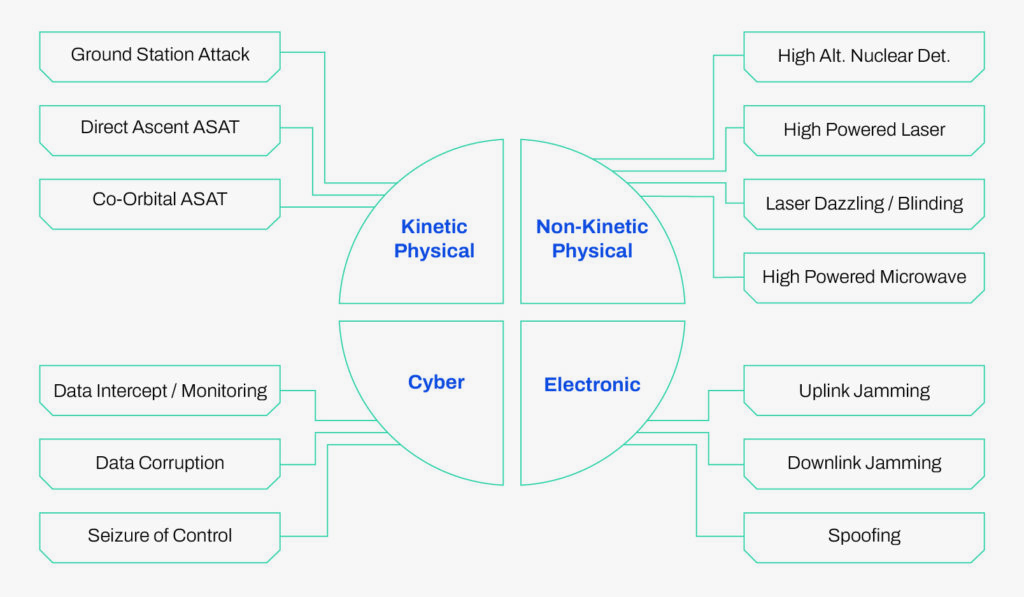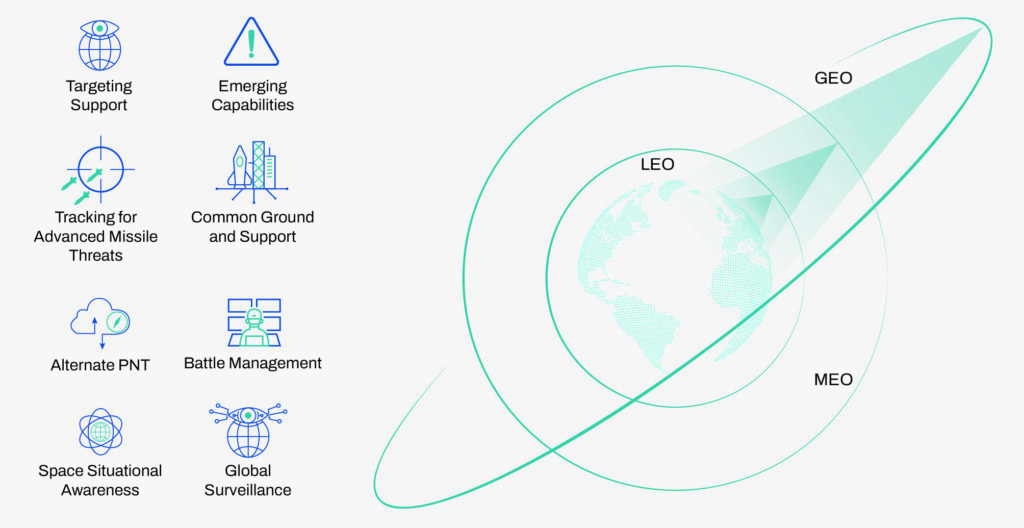Introduction
Space is not a sanctuary that sits as a serene and peaceful commons untouched by intensifying major power rivalry below. Space is a contested and congested operational domain in which perceived norms of responsible behavior are built on fraying legal and regulatory foundations. The rapid development of counterspace capabilities by military actors, including now the prospect of nuclear-armed anti-satellite (ASAT) weapons in orbit that would explicitly violate Article IV of the 1967 Outer Space Treaty, means that warfighting in space must be seen to be highly likely in future wars. Furthermore, adversary grey zone operations in orbit can threaten vital space support at a level below, which would justify a military response.

For Australia as a new space power, investment in space capability to support terrestrial forces in joint and integrated military operations as part of multi-domain operations is a priority, but as a nation, we must embark upon our voyage to space without preconceived ideas that our access to space will always be assured. Australia, like other allies, will have to struggle to gain and maintain an appropriate degree of space control in the face of adversary actions and threat capabilities. Investment in satellite capabilities for communications (SATCOM), intelligence, surveillance, and reconnaissance (ISR), positioning, navigation, and timing (PNT), as well as other tasks, must be matched by the development of space domain awareness and, ultimately, space control capabilities. The issue of to what extent these capabilities and missions can be provided by sovereign or commercial solutions will also need to be determined.
A prudent step for Australia in contemplating the development of space capabilities for both military and civil purposes should be to strengthen space resilience and deterrence against current and near-term counterspace threats emerging from adversaries. This will demand a willingness to complement efforts towards diplomatic and legal efforts to strengthen laws and norms in space, with simultaneous development and rapid deployment of practical space domain awareness as well as space control capabilities to counter adversary threats and protect critical space architecture. In short, a policy of strategic patience and an assumption that our adversaries will not violate laws and norms of responsible behavior in space will not work.
This paper explores how these space capabilities – in terms of space support for terrestrial forces through SATCOM, ISR, and PNT – will support Australian Defense Force (ADF) joint and integrated multi-domain operations and considers how the ADF will also undertake deterrence by denial in space through space domain awareness and space control. It will also consider the importance of sovereign space launch (space lift) capabilities in contributing to space resilience and deterrence by denial in orbit through augmentation and reconstitution of space capabilities in the face of counterspace threats. It will conclude by exploring how these capabilities contribute to activities in the air domain as part of multi-domain operations.
Australia’s Approach to the Space Domain in Multi-Domain Operations
The 2024 National Defense Strategy (NDS) is the latest official defense policy statement that over-arches service-specific and joint and integrated operations within a multi-domain operational environment (Department of Defense, 2024). The NDS lays out the ADF’s defense strategy as seeking to ‘…deter any actions that could lead to conflict, military coercion or direct action against Australia…’ through a strategy of denial (Defense, 2024). This requires credible ADF capabilities to ‘complicate the calculus of any potential adversary…’ through ‘…increasing the range and lethality of the ADF, strengthening Australia’s national resilience and focusing Defense’s international engagement (Defense, 2024).
This need to deter and respond requires that the ADF demonstrate the capability and resolve to respond to and withstand attacks on Australian territory and protect Australian sea lanes of communication, amongst other broader tasks in defense cooperation and diplomacy. It requires an ADF that has increased lethality at a greater range and an ability to project power and presence across Australia’s primary area of military interest, as well as operating with key allies and partners, including the United States. The goal must be to hold at risk an enemy force, build resilience in the face of threats, enhance situation awareness, and ensure effective enabling capabilities that will support command and control (C2), ISR, and other key aspects of joint and integrated operations across all five operational domains (Defense, 2024).
This last aspect of the ADF’s denial strategy demands investment in space support capability. If Australia is to build sovereign space capabilities, part of that investment must be in assuring access to space and being willing to take the next step from space domain awareness to build a space control capability. This process of emphasizing the space domain for support of terrestrial forces in other domains, as well as space domain awareness as a means to ensure space control, should be a key objective for the next NDS and its accompanying Integrated Investment Program (IIP), to be released in 2026 as part of a biennial defense policy formulation process. Defense space command and defense, more broadly, need to re-emphasize the importance of the space domain in future policy formulation. Space capabilities have to become a priority, and the linkage between space power and the means for force projection – naval and air power – needs to be highlighted in future defense policy. The ADF will require investment into a full spectrum of space capabilities that will play a key role in supporting multi-domain operations, including through supporting long-range air power and space itself.
The 2024 NDS makes clear that ‘space and cyber capabilities that strengthen situational awareness, the ability to project force, and decision advantage…’ will be a priority in the coming decade for investment into an integrated focused force (Defense, 2024). The IIP goes into more detail, noting the importance of space capabilities that ‘…underpin the ADF’s warfighting effectiveness’ through providing communications, weather, intelligence, surveillance and reconnaissance and positioning, navigation, and timing information (Defense, 2024). The IIP notes that spending on space capabilities for the ADF will be increased from the planned AUD$7 billion in the previous government’s Force Structure Plan, released in 2020, to between AUD$9 billion and AUD$12 billion through 2034. However, the funding information in the 2024 IIP is vague, with the vast majority of increased funding unapproved (Defense, 2024).
Key space capabilities for the ADF
A key project in Australia’s future space capability is the development of what the IIP refers to as a ‘sovereign controlled’ satellite communications capability – the Australian Defense Satellite Communications (SATCOM) system. This will include up to four communications satellites, as well as ground stations and operations centers. This project, referred to as JP9102, has been approved, though it is yet to be fully funded, with Lockheed Martin nominated as the preferred contractor (Davis, 2023).

The emergence of proliferated Low-Earth Orbit (pLEO) mega-constellations such as SpaceX’s Starlink version for defense purposes, Starshield, would complement JP9102 (Erwin, 2024). Embracing pLEO-based small satellites for SATCOM has its advantages, as it could allow the ADF to exploit a larger number of satellites in LEO for not just SATCOM but also earth observation and other hosted payloads and better exploit optical communications technologies. Furthermore, a larger constellation in LEO is more resilient in the face of adversary counterspace threats. The critical disadvantage of a Starshield-type capability is that it is not a sovereign capability for Australia. Thus, a combination of large GEO satellites, complemented by pLEO Starshield-type mega-constellations, would provide the ideal mix of SATCOM capabilities for the ADF, preserving sovereign-controlled space support and reducing the risk of both counterspace threats that could generate catastrophic loss of space support for the ADF, and mitigate risks posed by reliance on a foreign satellite operator. This ‘best of both worlds’ option should be the basis for future ADF SATCOM, contributing to ADF space-based ISR requirements and other tasks in the next NDS and IIP in 2026.
In terms of Earth Observation and space-based ISR, the previous coalition government led by Prime Minister Scott Morrison had fully supported both a defense project known as DEF-799 Phase 2 for space-based ISR to support the ADF and for a civil Earth-Observation project known as the National Space Mission for Earth Observation (NSMEO) (Davis, 2019). The current Labor Government, led by Prime Minister Anthony Albanese, canceled NSMEO in the 2023-24 budget statement for the purposes of ‘budget repair,’ and the status of the DEF-799 Phase 2 project remains unclear (Shrimpton, 2023). The 2024 IIP makes a vague mention of ISR as important for ADF warfighting capabilities, but no specific mention of space-based ISR is forthcoming, nor does it provide any funding information on such a capability. For all intents and purposes, space-based ISR has disappeared from government discussion, and there is no information on the status of any programs for ADF use. To strike deep, the ADF must ‘see deep’ in a timely, responsive, and accurate manner, and this cannot happen absent a credible sovereign space-based ISR capability.
There are other key space-related tasks employed by the ADF, such as environmental monitoring for weather prediction, that is crucial to the conduct of multi-domain operations; missile early warning and tracking; and positioning, navigation, and timing (PNT) that employ global navigation satellite systems such as the U.S. Global Positioning System (GPS). Australia will not likely seek to deploy its own sovereign space capabilities to replicate these services. However, research and development within both the Australian Strategic Capabilities Accelerator (ASCA) and Defense Science and Technology Group (DSTG) are occurring towards quantum technologies that could mitigate the risk of degradation of PNT as part of ‘NavWar’ collaboration with the United States. AUKUS Pillar 2 encompasses priority technology areas, including quantum technology that could contribute towards complementary PNT-related technologies to GPS, which could be space-based. Counter-hypersonics research and development in terms of missile early warning and tracking is another AUKUS Pillar 2 technology priority area that could see investment in pLEO Earth Observation technologies and, ironically, would reinforce the importance of supporting sovereign space-based ISR in future NDS and IIP releases.
As noted, the current IIP refers to the decision (by the previous Morrison Government) for hosting the U.S. ‘Deep Space Advanced Radar (DARC) system at Exmouth in Western Australia, alongside a U.S. optical space surveillance telescope (Davis, 2023), and also maintains consistency with the previous Morrison Government’s support for Space Control as an ADF space operations task (Defense, 2024). The IIP states that planned spending will include ‘…measures to enhance Defense’s space control capability deny attempts to interfere with, or attack, Australia’s use of the space domain. These will help ensure the ADF is able to continue using the space capabilities it needs to support its operations.’ (Defense, 2024). As with other space capabilities, funding promises are vague, with the vast bulk of planned funding for ‘space sensors’ (as referring to space domain awareness) and ‘space control’ remaining ‘unapproved’ between 2024 and 2034.
If Australia is to acquire a space control capability, it is certain to be a ‘soft kill’ system that disables or denies rather than physically destroys a target. On 27th October 2022, the Albanese government signed a ban on destructive testing of kinetic kill ASAT systems that create space debris to promote a policy of sustainable use of space (DFAT, 2022). The former Morrison-led Coalition government announced a project – DEF 9358 – for ground-based space electronic warfare in 2021, and such a capability would be consistent with a preference for reversible or scalable effects that disable or deny rather than physically destroy (Defense, 2021).
The 2024 NDS and IIP, the 2022 Defense Space Strategy, and the 2020 Defense Strategic Update and Force Structure Plan have shown a consistent shift by Australia away from the traditional passive dependency on foreign state and commercial space capability providers towards a greater focus on sovereign capability. So, what are the next steps?
The future role of a sovereign space launch (space lift) is important, as it allows greater independent and sovereign access to space for ADF and allied space capabilities to either augment critical space support in a crisis or rapidly reconstitute lost capability in the aftermath of an adversary counterspace attack. Such a capability, alongside space control, allows Australia to burden share in orbit to a much greater degree by strengthening both Australian and allied space resilience, and reinforcing deterrence by denial in orbit.
Australian companies such as Gilmour Space Technologies and Southern Launch, Space Centre Australia, as well as Equatorial Launch Australia are moving rapidly towards establishing Australian launch sites, and Gilmour is preparing to launch its Eris 1 orbital launch vehicle from its launch site in Bowen, Queensland. As with space control, it will be important for the next NDS and IIP to recognize the importance of commercial space launch as a key capability that contributes towards ADF space operations. The current NDS and IIP ignore this critical component of national capability completely (Davis, 2024).
Australia is to acquire a space control capability, it is certain to be a ‘soft kill’ system that disables or denies rather than physically destroys a target.
Dr. Malcolm Davis
Space and ADF Multi-Domain Operations in Future Warfare
It is clear that Australian defense policy as it relates to space has transformed in recent years, but any investment into space capabilities needs to directly enable and enhance military effectiveness on Earth for it to be useful. In the air domain, the 2024 IIP makes little change to the RAAF’s current or planned force structure through to 2034 and, in fact, reduces capability by not funding a previously planned fourth squadron of F-35A Joint Strike Fighters. Instead, F/A-18F Super Hornet and E/A-18G Growlers will continue operating through 2040. Investment in the MQ-28A Ghost Bat collaborative combat aircraft (CCA) will continue, but it now appears the platform will initially be configured for an unarmed ISR role, with any commitment towards an armed version somewhat vague. Other force elements of the RAAF, in terms of ISR and air mobility, show little change beyond long-term suggestions for an eventual replacement of the E-7A Wedgetail Airborne Early Warning and Control aircraft.
Yet, even as the current government seems content to embrace a status-quo approach to RAAF operational capability development, in spite of a rapidly worsening strategic outlook, important changes in air power technology and concepts are taking place that should challenge this ‘steady as she goes’ mindset in the next NDS and IIP in 2026. Sixth-generation projects such as the USAF Next Generation Air Dominance (NGAD) and U.S. Navy F/A-XX continue to progress, though the former is under significant review, while the UK-Japan-Italy Global Combat Air Platform (GCAP) is generating great interest as a possible long-range strike-fighter (Sweetman, 2024). If RAAF F/A-18F and E/A-18G are to be retired by 2040, as suggested in the IIP, then decisions about their replacement will need to be made in the coming years, either in the 2026 or certainly 2028 IIP. Add to this looming decision is the growing significance of CCA and its role in reshaping the nature of air combat operations, particularly in terms of re-introducing mass to the air domain at lower cost than crewed platforms, and the RAAF has important choices to make in coming years.
The impact of CCA, in particular, is crucial. With the USAF and European air forces now investing in this new type of human-machine teaming capability, Australia must keep pace with this important development. Ensuring resilient connectivity between a crewed platform and autonomous systems beyond the horizon will inevitably fall on satellites, probably pLEO mega-constellations, to allow the management of multiple CCA platforms with humans ‘on the loop’. At the same time, that pLEO constellation can allow human-controlled platforms to see deep and ensure a high degree of tactical situational awareness in the air domain and across the electromagnetic spectrum. Providing that space-based information architecture as a backplane for multi-domain operations in the air, sea, and land is far more efficient than relying on terrestrial C2 infrastructure. And pLEO satellite mega-constellations are more resilient to counterspace threats than large, individual satellites in GEO.
In a future crisis, space capabilities for SATCOM, ISR, and PNT will be crucial for a full range of military tasks across all five domains, including in space itself. For example, imagine a scenario in which Australia is defending its air and maritime approaches against an adversary projecting force towards Australia’s northern landmass. For the RAAF in such a scenario, it will be vital to ensure an ability to gain and maintain control of the air to counter sea-based or air-based threats. Satellites will facilitate ‘over the horizon’ command and control networks between ground command centers ashore and RAAF combat aircraft operating in Australia’s northern air approaches that are undertaking reconnaissance, air defense, and strike missions. The air platforms, be they fast combat aircraft such as RAAF F-35As, F/A-18Fs or E/A-18Gs, or maritime patrol aircraft such as the P-8A or MQ-4C, can then exchange ISR data with naval surface combatants, receive data via satellite links from other air platforms, or even support ground units operating in forward deployments that are equipped with long-range missile capabilities such as the 500km range Precision Strike Missile (PRsM).
Ensuring resilient SATCOM links to allow the ADF to act on real-time space-based ISR information is crucial in this scenario. In particular, the RAAF’s F-35A’s ability to exploit data integration with offboard sensors is a key advantage, allowing it to exploit stealth to its maximum potential whilst maintaining situational awareness and exploiting surprise for the delivery of over-the-horizon standoff weapons, which themselves can be guided by GPS. That same F-35A can then act as a node in a networked system of systems to allow naval surface combatant and land forces to attack a detected adversary fleet or to enhance the air defense of naval forces.
The combination of advanced SATCOM, based around both pLEO mega-constellations of small satellites with larger GEO-based satellites and ISR satellites, becomes the central backplane for a networked multi-domain operational concept for the defense of Australia. Satellite PNT provides precision navigation and targeting information for advanced standoff weapons, and the timing aspect of PNT is essential to manage data flowing through a multi-domain command and control system.
This demands assured and survivable space capability, which is resilient in the face of adversary counterspace attacks. Investing in space-domain awareness and space control gives the ADF some chance to assure access to vital space systems. Supporting sovereign space lift enhances the ability to maintain that access, even in a contested space domain.
Finally, research and development into quantum technologies may ultimately see a complementary capability for high-speed, secure communications, navigation, and, potentially, sensing. Quantum technology is a priority area for AUKUS Pillar 2, which could have a huge impact on traditional military operations, but, like AI, it remains an immature technology that could be some years away from realizing practical applications in multi-domain operations in future war.
Satellite PNT provides precision navigation and targeting information for advanced standoff weapons, and the timing aspect of PNT is essential to manage data flowing through a multidomain command and control system.
Dr. Malcolm Davis
Conclusion
Space will continue to play a critical role in current RAAF operations and in supporting key capabilities in multi-domain operations. That role will grow in the future, particularly if the RAAF is to fully embrace CCA as a key air combat capability by the 2030s. Assuring resilient C4ISR from space will demand resilient space architectures, which in turn will demand that the ADF fully support an expansion of its space domain awareness capability and invest in sovereign space control and sovereign space launch.
As Field Marshal Montgomery stated regarding the lessons of operational experience in the Second World War on the importance of air power that if we lose control of the air, we lose the war and we lose it fast.’ In the 21st century, that observation is more relevant than ever for the space domain.
References
Col. Meilinger, P. (1995). Ten Propositions Regarding Air Power. Washington, DC: Air Force History and Museums Program. Available from: https://media.defense.gov/2010/May/25/2001330281/-1/-1/0/10_propositions_regarding_air_power.pdf
Davis, M. (2019), Force’s bold launch into space projects [Online] The Australian. Available from: https://www.theaustralian.com.au/national-affairs/defense/australia-must-be-a-space-power/news-story/5b3de8002129fe29d1c207446859adc6
Davis, M. (2023), ADF a step closer to state-of-the-art satellite system [Online] The Strategist. Available from: https://www.aspistrategist.org.au/adf-a-step-closer-to-state-of-the-art-satellite-system/
Davis, M. (2023), Seeing through the DARC, deep into space [Online] The Strategist. Available from: https://www.aspistrategist.org.au/seeing-through-the-darc-deep-into-space/
Davis, M. (2024), National Defense Strategy: a missed opportunity for space [Online] The Strategist Available from: https://www.aspistrategist.org.au/national-defense-strategy-a-missed-opportunity-for-space/
Department of Defense. (2024), National Defense Strategy and Integrated Investment Program. Department of Defense. Available from: https://www.defense.gov.au/about/strategic-planning/2024-national-defense-strategy-2024-integrated-investment-program [31 October 2024].
Department of Defense. (2021), Defense explores options for Space Electronic Warfare [Online] Available from: https://www.minister.defense.gov.au/media-releases/2021-07-29/defense-explores-options-space-electronic-warfare
Erwin, S. (2024), Pentagon embracing SpaceX’s Starshield for future military SATCOM [Online] Space News Available from: https://spacenews.com/pentagon-embracing-spacexs-starshield-for-future-military-SATCOM/
Shrimpton, B. (2023), Australia’s space future is at risk, with massive implications [Online] The Strategist. Available from: https://www.aspistrategist.org.au/australias-space-future-is-at-risk-with-massive-implications/
Sweetman, B. (2024), The doubtful future of the U.S. Air Force’s planned NGAD fighter [Online] The Strategist. Available from: https://www.aspistrategist.org.au/the-doubtful-future-of-the-us-air-forces-planned-ngad-fighter/
Wong, P. (2022), Australia advances responsible action in Space [Online] Available from: https://www.foreignminister.gov.au/minister/penny-wong/media-release/australia-advances-responsible-action-space







